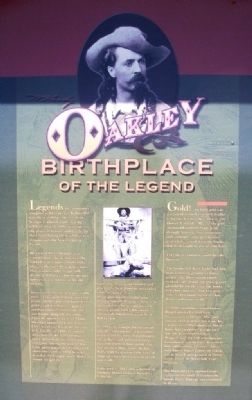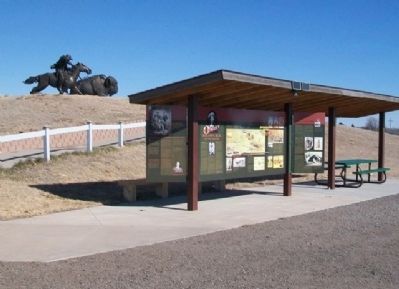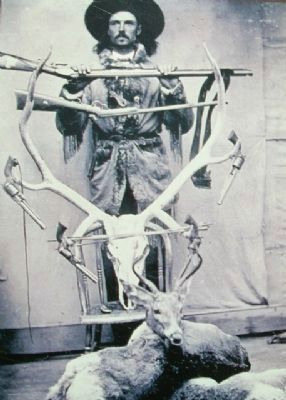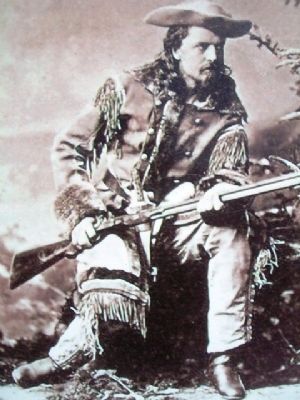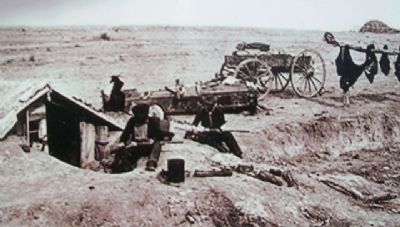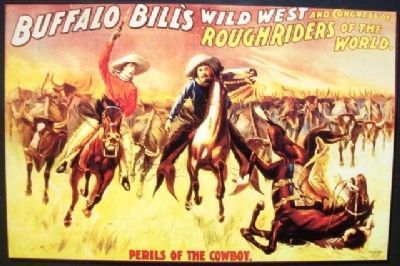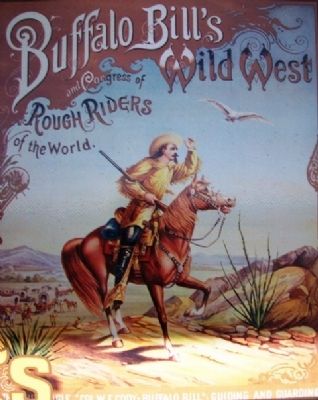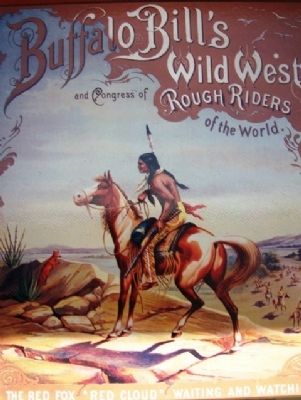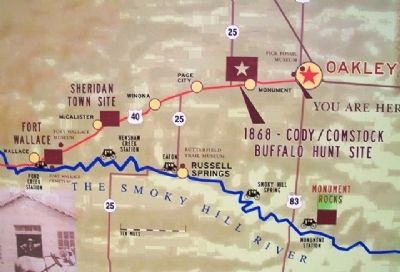Oakley in Logan County, Kansas — The American Midwest (Upper Plains)
Oakley: Birthplace of the Legend
Legends are sometimes too good to be true, but Buffalo Bill was the real thing. He was born William Frederick Cody in a log cabin in Iowa in 1846, grew up on the plains of Kansas, and fought for the Union during the Civil War as a trooper with the Seventh Kansas Cavalry.
He earned his credentials as a frontiersman. At various times he worked as a trapper, a bullwhacker (driving the oxen for wagon trains), Pony Express rider, stagecoach driver, and hunter. But he became famous as a civilian scout for the military.
Scouts were the eyes and ears of the army. They guided troops over the plains, found water and hunted fresh game, trailed Indian war parties, acted as couriers and translators, and fought alongside the soldiers. From the moment General Philip Sheridan appointed Cody to be Chief Scout and Guide for the 5th U.S. Cavalry in 1868, he was on army payrolls for four consecutive years, more than any other scout and guide during the Indian Wars. Cody participated in 19 battles and skirmishes, and in 1872 he was awarded the Congressional Medal of Honor for gallantry.
Later that year, dime-novelist and playwright Ned Buntline persuaded Cody to appear in a blood-and-thunder melodrama, playing himself on stage. He was so successful that he started his own theater group with fellow scouts Texas Jack Omohundro and Wild Bill Hickok.
In 1883, he brought Indian people together with cowboys, cavalrymen, outlaws and lawmen, sharpshooters, elk, buffalo, and 200 horses in a two-and-one-half hour arena show. For the next thirty years, Buffalo Bill's Wild West carried the story of America's West to millions of people worldwide.
Cody died in 1917 and is buried on Lookout Mountain near Denver, Colorado.
———————
Lucretia Borgia
This rifle is the same model as Buffalo Bill's favorite hunting rifle. He took the name from Victor Hugo's play "Lucretia Borgia," popular in the United States during the 1860s. It told the story of the Italian noblewoman Lucrezia Borgia (1480-1519) who was rumored to have murdered members of her own family for political gain. The name of the "pretty poisoner" seemed like a good, deadly label for a gun.
Shown here [a photo on the marker] at actual size, this gun is a .50/70 caliber Springfield model 1866 "trapdoor" rifle. The trapdoor mechanism (or 2nd Allin conversion) changed the model 1863 Civil War muzzle-loading musket into a breechloader which took metallic cartridges. It weight over 11 pounds when loaded.
This gun is on display at the Fick Fossil Museum in Oakley.
———————
Gold!
In 1859 gold was discovered in the far western reaches of Kansas Territory near what is now Denver, Colorado. Most of the gold rushers followed the Platte River through Nebraska, but prospectors and promoters in eastern Kansas claimed that a trail along the Smoky Hill River would be shorter and faster.
They never claimed it would be safer, however.
The Smoky Hill River Valley had long been a hunting ground for native peoples, but there was no clearly marked trail. Wood and grazing were plentiful for travelers, but the Smoky Hill often runs dry. The first gold seekers often found themselves lost, thirsty, and under attack.
In 1860 a promoter named Green Russell surveyed a road from Leavenworth to Denver. The route became more practical, but it saw few travelers until 1865 when Col. David Butterfield established a stagecoach line, the Butterfield Overland Dispatch, over the 592 miles between Leavenworth and Denver. Butterfield built stations every 12 miles. There were four in Logan County including one at Russell Springs south of Oakley, home now to the Butterfield Trail Museum.
The Butterfield line operated under various owners until 1870 when the Kansas-Pacific Railroad was completed to Denver.
———————
The Kansas Pacific Railroad
It was not until after the Civil War that America's great unifying endeavor, the building of the Transcontinental Railroad, actually began. The chosen route followed the Platte River, north of Kansas. By 1867, citizens in the growing city of Denver demanded a direct link to Kansas City, and Texas cattlemen clamored for closer shipping depots.
Construction began quickly, and cowboys just as quickly began driving their herds north to railheads at Abilene, Dodge City, and points west. By 1868 the rails had reached Sheridan, just west of Oakley.
When funds ran short and construction stalled, Sheridan became a rough camp of canvas-covered dugouts. It was a haven for heavy-drinking buffalo hunters, railroad laborers, outlaws, and horse traders, and it was a watering hole for soldiers patrolling the dangerous no-man's land between Fort Hays and Fort Wallace. It was at Sheridan that Buffalo Bill raffled off his horse Brigham.
And it was 20 miles east of Sheridan where the great buffalo hunting contest between Bill Cody and Billy Comstock is said to have begun.
Erected by Wild West Historical Foundation and the Kansas Humanities Council.
Topics. This historical marker is listed in these topic lists: Animals • Entertainment • Industry & Commerce • Settlements & Settlers. A significant historical year for this entry is 1846.
Location. 39° 7.611′
N, 100° 52.156′ W. Marker is in Oakley, Kansas, in Logan County. Marker is at the intersection of U.S. 83 and 2nd Street, on the left when traveling north on U.S. 83. Marker is in the kiosk adjacent to the Buffalo Bill Cultural Center. Touch for map. Marker is at or near this postal address: 3083 US Hwy 83, Oakley KS 67748, United States of America. Touch for directions.
Other nearby markers. At least 8 other markers are within walking distance of this marker. Annie Oakley (here, next to this marker); The Monument Rocks (here, next to this marker); Inhabitants of the Kansas Plains (here, next to this marker); The Smoky Hill River Valley - Buffalo Country (here, next to this marker); Early Exploration across Kansas (here, next to this marker); The Great Buffalo Hunt (here, next to this marker); Buffalo Bill Cultural Center (within shouting distance of this marker); Logan County Sandstone (approx. 0.4 miles away). Touch for a list and map of all markers in Oakley.
Related markers. Click here for a list of markers that are related to this marker. John B. “Texas Jack” Omohundro
Also see . . .
1. William F. Cody ("Buffalo Bill"). (Submitted on June 16, 2013, by William Fischer, Jr. of Scranton, Pennsylvania.)
2. The Colorado Gold Rush. (Submitted on June 16, 2013, by William Fischer, Jr. of Scranton, Pennsylvania.)
3. Transcontinental Railroad at American Experience. (Submitted on June 16, 2013, by William Fischer, Jr. of Scranton, Pennsylvania.)
4. Railroads in Kansas. (Submitted on June 16, 2013, by William Fischer, Jr. of Scranton, Pennsylvania.)
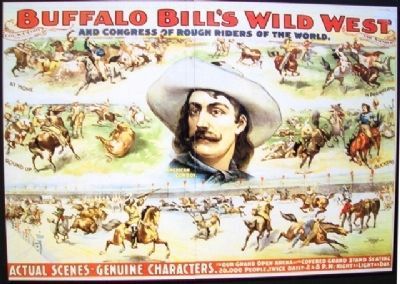
Photographed By Unknown, undated
6. Poster on Oakley: Birthplace of the Legend Marker
Credits. This page was last revised on February 8, 2021. It was originally submitted on June 16, 2013, by William Fischer, Jr. of Scranton, Pennsylvania. This page has been viewed 1,200 times since then and 32 times this year. Last updated on April 28, 2018, by Cosmos Mariner of Cape Canaveral, Florida. Photos: 1. submitted on June 16, 2013, by William Fischer, Jr. of Scranton, Pennsylvania. 2. submitted on June 15, 2013, by William Fischer, Jr. of Scranton, Pennsylvania. 3, 4, 5, 6, 7, 8, 9, 10. submitted on June 16, 2013, by William Fischer, Jr. of Scranton, Pennsylvania. • Andrew Ruppenstein was the editor who published this page.
